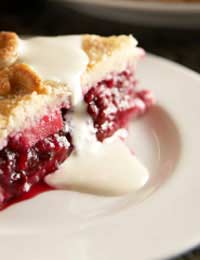
If you’re faced with a glut of fresh vegetables or fruit, you can save space by using your freezer as an extra storage area. Here are some tips and recipes for making the most of your freezer space.
Freezing Tips
Put everything into containers that are completely airtight, to avoid the entry or loss of moisture. To make sure you retain nutrients, it’s vital to cool the cooked dish or vegetables as quickly as you can. Cover loosely with clingfilm and put over ice or in a bowl of cold water. When you are ready to eat, thaw each package in the fridge overnight – don’t try to quick-thaw it with boiling water. When reheating, stir very little and allow the food to come to boiling point slowly.
Freezing Vegetables
If you are freezing vegetables plain – such as chopped runner beans or podded peas – it’s best to blanch them first. This has been shown to give better taste and nutrition on thawing. To blanch, simply bring a large pan of water to a rolling (hard) boil, and drop the prepared vegetables into the water. As soon as the water returns to the boil, lift out the vegetables using a slotted spoon, and allow them to steam-dry in a colander. Put over a bowl of ice, then bag and put into the fridge for another half-hour before freezing, labelling each portion with the contents and date as you go.
Root vegetables should be put into storage using the heeling-in technique or put in trays of sand or compost. It would not be recommended freezing the following: lettuce, courgette, aubergine, radish, spring onion or potato.
Freezing Fruit
Soft fruit such as apricots, peaches, apples, plums, and rhubarb, are all better frozen after they have been cooked. Stew them with a little sugar or poach them in syrup (and you can bottle them instead using this option), then freeze as above. Berries, meanwhile, are best frozen individually so you don’t end up with a heap of berry mush. Arrange them on a tray so they’re not touching, then put straight into the freezer. Remove a few hours later and bag up the berries. Alternatively, turn your fruit into smoothies or ice-cream (using any of your favourite recipes) and freeze in airtight containers. Drink or eat whilst almost thawed.
Apple Pie or Crumble Filling
This is a great way to use up an apple bounty, and tastes great with sharp English apples like Bramleys. The quantities are vague because you should taste the fruit and decide how much sugar/lemon you’d like.
3 large apples.
2tbsp unsalted butter
1-4tbsp Muscovado sugar.
Juice of ¼ – ½ lemon.
Peel, core and finely slice the apples. Melt the butter in a wide pan and add the apple slices, turning quickly to coat. Add the sugar and keep over a medium heat until the apples are caramelised and starting to soften around the edges. Cool quickly and freeze.
To use your crumble filling, defrost it thoroughly in the fridge. Spoon it into a large, ovenproof dish and top with crumble mixture before baking.
Essential Tomato Sauce
Reduce fresh tomatoes to make a rich tomato sauce that can be used in dozens of ways all year. It can be spread on pizza bases, tossed through vegetarian spaghetti, poured over sausages, dolloped on burgers, or spiced up to make a chilli. This is an excellent way to use up a glut, and will keep in the freezer for 3 to 4 months.
750g fresh tomatoes.
1tbsp balsamic vinegar.
1tsp sugar.
1tsp salt.
Chop the tomatoes, removing the green stalk at the top. Put into a large pan with all of the remaining ingredients, and bring to a boil. Squish the tomatoes against the side with a wooden spoon, then turn down the heat and let the tomatoes simmer very gently for about an hour – you want a very thick, pulpy reduction. If there is still liquid puddled around the pan, raise the heat to drive it off. Chill quickly, then spoon into bags, label, and freeze.
